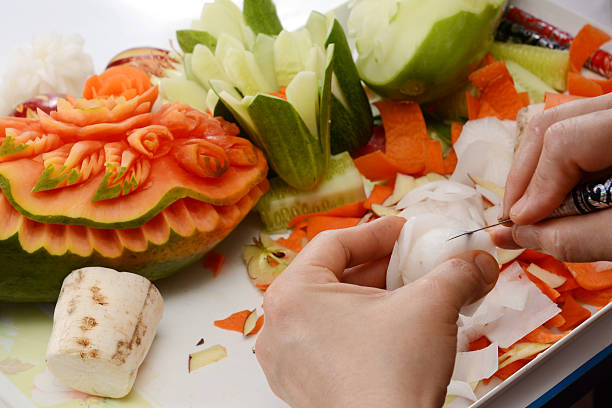Diving into the Intricate Art of Thai Fruit Carving
Thai fruit carving is a centuries-old tradition that transforms ordinary fruits and vegetables into exquisite works of art. This culinary practice has been passed down through generations, and today it's experiencing a global resurgence. In this article, we'll take a closer look at this intricate culinary art form, from its historical roots to its modern applications.

Section: The Origins of Thai Fruit Carving
Thai fruit carving, also known as Kae Sa Luk, dates back to the 14th century during the Sukhothai dynasty. It was initially practiced by royal chefs to enhance the presentation of royal meals. The carvings often depicted animals, flowers, and mythical creatures, symbolizing prosperity and good fortune. Over time, the art became popular among the common people and has continued to evolve.
Section: The Tools and Techniques
The art of Thai fruit carving requires precision, patience, and a steady hand. It is typically done with a small, sharp knife, often specially designed for fruit carving. The carver begins by choosing a suitable fruit or vegetable, then sketches the design onto the surface. Next, the carver carefully cuts and peels away the skin to reveal the design.
Section: The Role of Thai Fruit Carving Today
Today, Thai fruit carving is recognized as a significant aspect of Thai culture. It’s taught in schools, showcased in festivals, and utilized in restaurants to elevate the dining experience. It’s not only about making food look beautiful but also about preserving a cherished tradition.
Section: Thai Fruit Carving Going Global
With the rise of social media, Thai fruit carving has gained international attention. Online tutorials and workshops have made it accessible to anyone interested in learning the art. Food enthusiasts and professional chefs worldwide are now integrating Thai fruit carving into their culinary repertoire, adding a touch of elegance to their dishes.
Section: Interesting Facts and Tips about Thai Fruit Carving
- The first recorded Thai fruit carving was a decorative bird made from a vegetable for a royal festival.
- Watermelons, papayas, and pumpkins are popular choices for beginners due to their large size and firm texture.
- Thai fruit carving is often used to decorate food during Songkran, Thailand’s New Year festival.
- A professional fruit carver can take up to 6 hours to complete a complex design.
In conclusion, Thai fruit carving is much more than just a culinary technique. It’s a vibrant art form that reflects the richness of Thai culture and its appreciation for beauty and detail. By exploring this fascinating art, we not only add an extra dimension to our culinary skills but also gain a deeper understanding of a cultural tradition that has withstood the test of time. Whether you’re a professional chef or a home cook, diving into the world of Thai fruit carving can bring an exciting, creative twist to your culinary journey.




